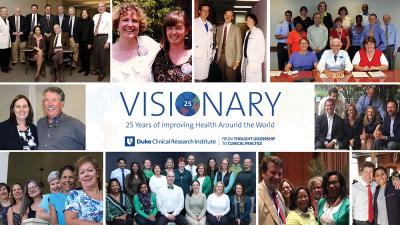

Duke Clinical Research Institute's 25 Years of Vision
From the moment that Adrian Hernandez, MD, MHS, professor of medicine in cardiology, stepped to the helm of the Duke Clinical Research Institute (DCRI) in May 2020, he faced the prospect of steering the organization through uncharted and fast-changing waters.

The world was in the early throes of the COVID-19 pandemic. The DCRI, the world’s largest academic clinical research organization, houses eight primary therapeutic areas, from musculoskeletal to neuroscience, under one roof. Now it was all hands on deck to face COVID. Experts in infectious disease, critical care, pediatrics, and cardiology alike pivoted to focus on pandemic-related research in addition to their primary research programs. Faculty and staff worked day and night to organize and launch new research programs aimed at answering urgent questions, such as understanding how frontline health care workers were affected by the pandemic and investigating whether approved drugs could be repurposed to treat COVID-19 symptoms at home. The DCRI soon became Duke University’s largest recipient of federal research dollars for COVID-19.
Things were changing not only within the DCRI, but across the entire clinical research ecosystem. Telehealth or virtual visits became commonplace, and it soon became clear that more research could be conducted remotely outside the clinic by leveraging digital health technologies and meeting patients in their communities. Faced with the need to rapidly develop COVID-19 vaccines, scientific processes that would normally take years were accelerated and completed successfully in a fraction of that time.
In response to the changing research world, Hernandez, who is also a vice dean for the Duke University School of Medicine, began to identify top priorities for the DCRI, among them a robust digital strategy and decentralized trials, which essentially take clinical trials to the subjects rather than gathering subjects together at a central site.
But as Hernandez charted the path for DCRI’s future and responded to so much change, he was also struck by what had held fast: the institute’s mission to develop, share, and implement knowledge that improves health around the world through innovative clinical research.
“DCRI’s employees are profoundly mission-oriented,” said Hernandez. “Everyone quickly leaned in to developing creative and trustworthy methods for addressing the most pressing questions of the pandemic.”
An Enduring Vision
Upon becoming executive director, Hernandez gently finessed the mission statement, changing “improving patient care around the world” to “improving health around the world” to reflect DCRI’s expertise in preventive care and health for all.

Overall, however, the thrust of the DCRI’s mission remains unchanged from what it was 25 years ago when the institute was founded by Robert Califf, MD (currently nominated for a second stint as commissioner of the U.S. Food and Drug Administration).
During this 25th anniversary year, the DCRI has reflected on its first quarter-century — and on where the next quarter-century will take it. When current and former faculty and staff — including Hernandez and the other four individuals who have had a turn as executive director — talk about the institute, the theme that arises again and again is the DCRI’s enduring vision, which underpins its mission and activities.
“The Duke Clinical Research Institute, which was formally created 25 years ago, began with a vision: to usher in a different approach to learn about health and illness, and to apply these learnings to improve health care,” said Califf, who led the institute from its inception in 1996 until 2006.
Over the past 25 years, that vision has coalesced into five broad categories of endeavor:
Generating World-Class Evidence to Improve Health
Central to DCRI’s vision and mission is the process of evidence generation through clinical trials and observational studies. Cardiologist Robert Harrington, MD, who was the DCRI’s executive director between 2006 and 2012 and is now Arthur L. Bloomfield professor of medicine and chairman of the department of medicine at Stanford University, said collaboration was key.

Harrington said the DCRI always fostered a strong collaborative spirit both internally and externally. Projects succeeded because a unique bond formed among clinicians, statisticians, and operational experts who were able to work together seamlessly to deliver on research efforts. The DCRI was also successful in collaborating with academic partners and pharma companies outside its walls to complete successful studies and help advance development of new treatments.
The culture of mutual support and collaboration is deeply embedded in the DCRI, and Harrington expects it to continue to yield benefits even as technology and science evolve rapidly.
“There are a lot of questions in clinical medicine that we don’t know the answer to,” Harrington said. “And I’m confident that the next version of DCRI will focus on how we collect data and turn it into evidence and informed clinical practice going forward.”
Sharing and Implementing Knowledge Widely
As an academic institution, the DCRI regards peer-reviewed publication as an essential part of the research process because it enables researchers to share scientific findings with their peers across academia and industry.

Since DCRI’s inception in 1996, the institute has disseminated over 17,500 publications, and findings from the DCRI have been cited in over 760,000 scientific articles. Several researchers with ties to the DCRI are named year after year to a global “highly cited researchers” list, including cardiologist Eric Peterson, MD, MPH, who directed the institute from 2012 to 2018 and is now vice provost and senior associate dean for clinical research as well as vice president for health system research at UT Southwestern Medical Center.
DCRI’s commitment to sharing knowledge extends far beyond just academic publications. In recent years, the institute has become a leader in developing research summaries for lay audiences and implementing other strategies to share study results with people who participated in the studies.
The DCRI is also heavily focused on implementation science: determining the most effective ways to implement evidence-based therapies and treatment strategies into clinical practice. This focus is narrowing the gap between research projects and treatment protocols — a much-needed change in an environment in which it takes an average of 17 years for clinical trials results to be adopted into patient care.
“Researchers do research for many reasons, and many are driven by knowing the answer,” Peterson said. “But at the DCRI, it’s not just about that; it’s about helping patients. While we certainly do research for the academic and intellectual reasons, the main reason is to impact the world and learn about how we treat patients, and ultimately, how we can care for them better. To get to that spot, we need to disseminate the findings of our work.”
Creating Novel Methods that Accelerate Clinical Research
The DCRI could not generate evidence successfully without continuously developing novel methods to answer increasingly difficult questions and make research more efficient. From the explosion of big data to the rapid emergence and spread of a never-before-seen disease, recent events have underscored the need for great minds to work on new ways to solve problems.

The DCRI has employed novel approaches in many of its research projects, such as successfully conducting the demonstration project showing how to leverage the National Patient-Centered Clinical Research Network (PCORnet), or leading the way in newer, more flexible trial designs. Duke population health scientist Lesley Curtis, PhD, who led the institute as its interim executive director from 2018 to 2020, said that DCRI’s ability to create novel methods has helped the institute address urgent needs.
“DCRI creates new ways of doing things not just for the sake of creating new methods and new ways of doing things, but to solve specific problems,” she said. “And those problems are often barriers that prevent us from — or maybe impede us from — generating the kind of evidence that patients and clinicians need. It’s really imperative for us to keep our creative thinking caps on.”
Improving Health Equity through Our Research
As Hernandez looks to the future of the DCRI, he sees improving health equity as one of its most important goals. While the DCRI has long endeavored to improve health for all, Hernandez and other institute leadership know that greater steps must be taken to reach this goal.
Study teams, for example, must work to enroll more diverse study populations so that results from clinical trials can be accurately applied to all populations. There are many root causes for the current lack of diversity in the clinical trial environment, one of which is a lack of diversity in clinical trials leadership.
Hernandez has committed to addressing these and other related issues through instating a Diversity, Equity, and Inclusion (DEI) office within the DCRI. Longtime Duke and DCRI employee Linda Davidson-Ray, MA, was selected to lead this office. She is tasked with strengthening DEI efforts within the DCRI, collaborating with the Duke School of Medicine’s Office of Diversity and Inclusion, and developing a platform for health equity research that can be shared and built upon with external partners.
“Especially the last five years, we’ve seen these health inequities worsen in different areas of the country,” Hernandez said. “We have this national footprint where we can close the gap. We have the resolve to bring the best minds together, not only at DCRI or Duke, but with other partners as well across academia, industry, and government agencies. We’re directly trying to address this by bringing those stakeholders together to design the solutions, test them out, and then show what works and also what doesn’t work.”
Developing the Next Generation of Clinical Researchers
Perhaps the most critical part of DCRI’s vision, which will serve to advance both the institute and the clinical research field for the next 25 years, is its commitment to developing the next generation of clinical researchers.
Harrington began his research career as a fellow at the Duke Databank for Cardiovascular Disease, which laid the groundwork for the founding of the DCRI. Since then, under the leadership of Harrington and others, the DCRI Fellowship Program has been formalized and expanded, equipping over 300 trainees with the skills needed to lead the clinical trials of tomorrow. It includes trainees with a diverse range of expertise, from musculoskeletal research to nephrology to cardiology, and attracts trainees from across the globe, from Canada to Australia: thus far the program has trained 64 fellows from 22 non-U.S. countries.
But even before there was a formal fellowship program, training and mentoring were important values of the institute, ingrained into its mission from its earliest days.
“From the beginning, the forte of the DCRI was putting trainees into the mix of getting trials and outcomes studies done — working with the study coordinators and the data experts and the statisticians to learn how it's done,” Califf said.
And the consensus among directors past and present? That early mission still rings true today, and is delivered through DCRI’s vision.
“The mission is as relevant today — even with some tweaks to the wording — as it was when we first put it into play 25 years ago,” Harrington said. “My advice to future DCRI directors: Stay focused on the mission.”
Kaitlin Jansen is a former senior communications specialist at the Duke Clinical Research Institute.
DCRI Celebrates 25 Years
The DCRI was founded in 1996, following in the footsteps of Duke pioneers who envisioned novel ways to learn about health and health care. Twenty-five years later, that spirit of innovation has enabled the DCRI to affect change in most every aspect of clinical research and realize its mission to improve health around the world.